The Intel Optane SSD 900P 280GB Review
by Billy Tallis on October 27, 2017 9:30 AM ESTAnandTech Storage Bench - The Destroyer
The Destroyer is an extremely long test replicating the access patterns of very IO-intensive desktop usage. A detailed breakdown can be found in this article. Like real-world usage, the drives do get the occasional break that allows for some background garbage collection and flushing caches, but those idle times are limited to 25ms so that it doesn't take all week to run the test. These AnandTech Storage Bench (ATSB) tests do not involve running the actual applications that generated the workloads, so the scores are relatively insensitive to changes in CPU performance and RAM from our new testbed, but the jump to a newer version of Windows and the newer storage drivers can have an impact.
We quantify performance on this test by reporting the drive's average data throughput, the average latency of the I/O operations, and the total energy used by the drive over the course of the test.
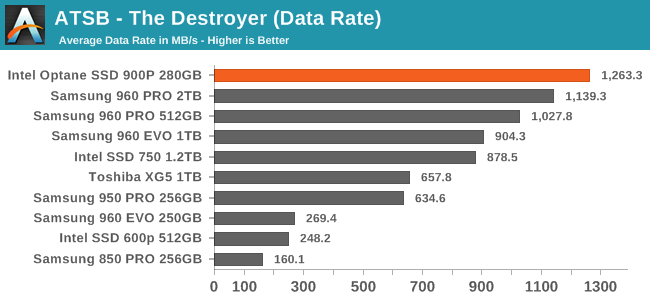
The Intel Optane SSD 900P sets a new record for average data rate on The Destroyer, beating the Samsung 960 PRO 2TB's score by about 10%, and beating the more similarly-priced 512GB 960 PRO by about 23%.
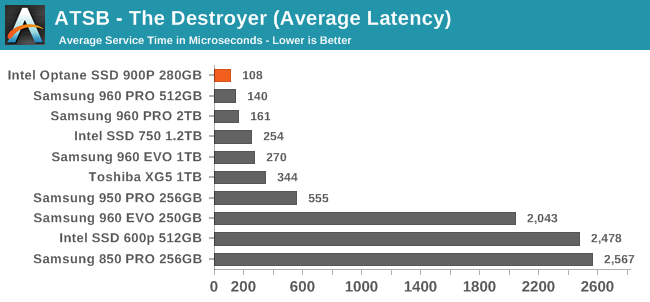
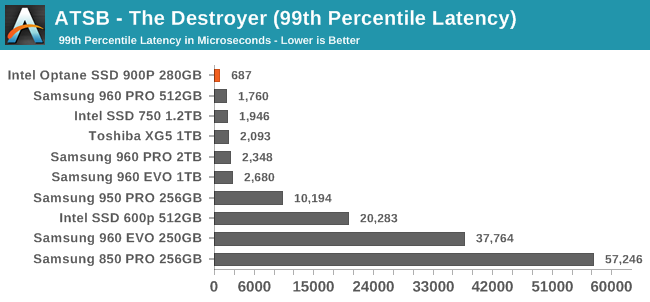
The average latency of the Optane SSD 900P on The Destroyer is a modest improvement over the previous record. The 99th percentile latency is a more significant 60% reduction over the previous record, putting the Optane SSD more clearly in a separate performance consistency class from high-end flash-based SSDs.
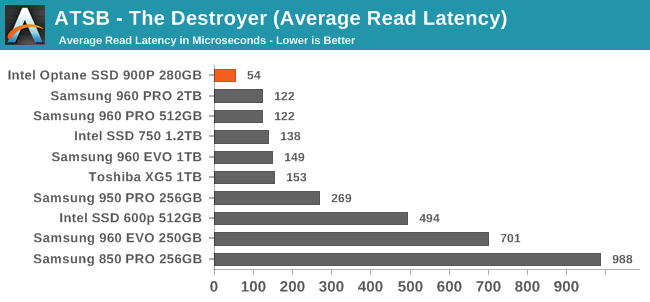
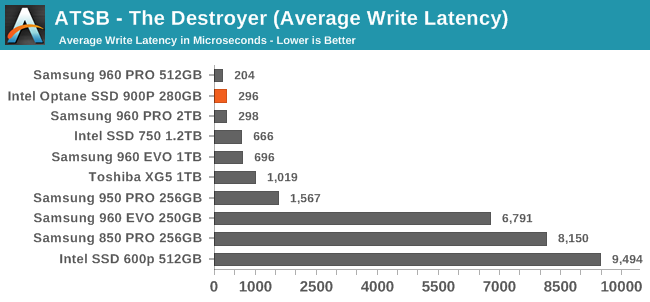
The average read latency of the Optane SSD 900P on The Destroyer is less than half that of any flash-based SSD, but the average write latency is a bit slower than the fastest flash-based SSDs.
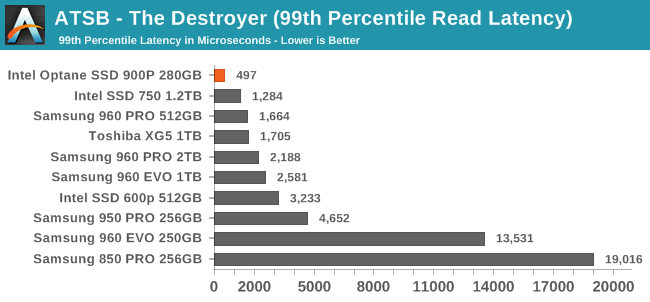
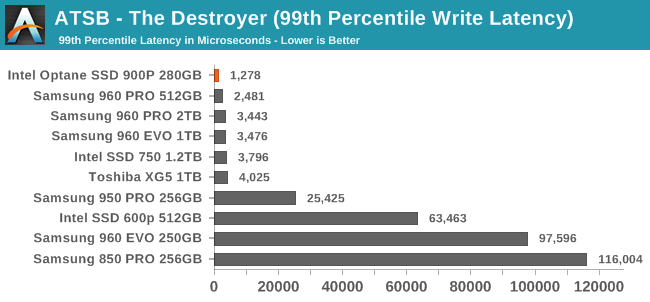
Even though the Optane SSD didn't set a record for average write latency on the Destroyer, its 99th percentile write latency is about half the previous record. The 99th percentile read latency beats the previous record by more than 60%.










205 Comments
View All Comments
lmcd - Friday, October 27, 2017 - link
Funny, when SSDs came out we were promised they'd be orders of magnitude faster than mechanical HDDs. The first ones weren't.Drumsticks - Sunday, October 29, 2017 - link
I think my primary point of criticism with your view is that, despite Intel not reaching their goals, it is measurably better than the competition at a better price per GB per performance.It might not have hit the endurance targets they wanted, but for 2-3x the cost of your opponent, they've achieved some 20x endurance, on par in the worst case, and 6-8 times better in many measurably important scenarios.
On top of that, you tout the benefits of SLC and claim that SLC is undeniably faster than XPoint, because if SLC wasn't held back by the cheap and underpowered controllers of yesteryear, it could really fly. How do you know the same thing is not true of 3DXP? Perhaps better understanding of its use and a better controller, and maybe a second generation of the memory, will enable Intel to reach even higher performance and endurance heights. You can't claim that SLC is better, and is simply held back by 2014 era controllers, while not allowing that 3DXP could likely be held back by it's controller as well. We have no idea what the performance ceiling for 3DXP is, because we've seen all of one generation of products.
To extend your analogy, I might be disappointed if I only received $450, but if everybody else is still only making $200, I'm going to go home happy.
Rektide - Friday, October 27, 2017 - link
This shows an Intel 900P with a total write endurance of 8.7PB, and a 850 Pro with a total write endurance of 150 TB. But a stress test of a 850 Pro in fact survived 9.1 PB[1]! Meanwhile, if you reach 8.7PB on the 900P, Intel will forcibly move your drive into read-only mode.If you look at Ark, Intel describes it's Endurance Rating to mean "Endurance rating indicates the expected data storage cycles to be expected over the life of the device." When they say that, they mean "and not a megabyte more". Whereas when Samsung says it, they, at least once, meant "but this drive may go 60x more than it's rating". I really severely dislike this twist of the knife, this drastic change Intel and Intel alone is perpetrating against it's consumers.
Does the P4800X also commit seppuku the megabyte it reaches it's Endurance Lifetime? I'm not sure if all Intel drives are so malicious, or is it consumer & enthusiast drives? How do I know which drives are programmed to self destruct on me, Intel?
[1] http://www.guru3d.com/news-story/endurance-test-of...
ddriver - Friday, October 27, 2017 - link
It is actually worse than locking in read-only mode - on the next boot cycle the drive gets bricked. So if you didn't manage to get that data in time, it is gone forever. Great feature.Spunjji - Saturday, October 28, 2017 - link
I have seen this with Intel consumer SSDs. It's amazing - it doesn't even tell you that it's failing and that you have one (yes, one) chance to backup your data before it goes forever. Usually the drive just throws an error, so your average user reboots the system and bam, the drive's not even in the BIOS anymore.Their drive failure behaviour is criminal.
voicequal - Saturday, October 28, 2017 - link
Agreed - bricking is a terrible failure mode for a consumer drive. For an enterprise drive, it *might* make sense, since its you want things to fail hard and fast so that backup systems can detect and take over.FwFred - Friday, October 27, 2017 - link
Wow, need a block button to improve SnR.Meteor2 - Tuesday, October 31, 2017 - link
Indeed -- though I simply skip any comments written by ddriver. Never any value in them (but a remarkably effective troll).Lolimaster - Saturday, October 28, 2017 - link
The 1000X was supposed to be on latency and endurance, not much more, and maybe 10X random 4K performance.CajunArson - Friday, October 27, 2017 - link
I thought you were a reliable AMD koolaid drinker?It's funny how you insult these products that you have never used but would never in a million years hurl their $7000 Radeon SSG under the bus... you know, the one that uses a consumer-grade GPU slapped together with a RAID-0 array of cheap consumer-grade NVME drives to supposedly do rendering jobs faster than a regular GPU.